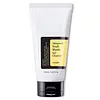What's inside
What's inside
 Key Ingredients
Key Ingredients

 Benefits
Benefits

 Concerns
Concerns

 Ingredients Side-by-side
Ingredients Side-by-side

Water
Skin ConditioningAcrylates Copolymer
Butylene Glycol
HumectantGlycerin
HumectantDisodium Laureth Sulfosuccinate
CleansingSodium Cocoyl Isethionate
Cleansing1,2-Hexanediol
Skin ConditioningCoco-Glucoside
CleansingLauryl Betaine
CleansingSnail Secretion Filtrate
Skin ConditioningArginine
MaskingTromethamine
BufferingPotassium Cocoyl Glycinate
Parfum
MaskingCarbomer
Emulsion StabilisingSodium Chloride
MaskingEthylhexylglycerin
Skin ConditioningAcrylates/C10-30 Alkyl Acrylate Crosspolymer
Emulsion StabilisingSodium Polyacrylate
AbsorbentDisodium EDTA
Water, Acrylates Copolymer, Butylene Glycol, Glycerin, Disodium Laureth Sulfosuccinate, Sodium Cocoyl Isethionate, 1,2-Hexanediol, Coco-Glucoside, Lauryl Betaine, Snail Secretion Filtrate, Arginine, Tromethamine, Potassium Cocoyl Glycinate, Parfum, Carbomer, Sodium Chloride, Ethylhexylglycerin, Acrylates/C10-30 Alkyl Acrylate Crosspolymer, Sodium Polyacrylate, Disodium EDTA
Benzoyl Peroxide 4%
Carbomer
Emulsion StabilisingDecyl Glucoside
CleansingDimethicone
EmollientDiheptyl Sodium Sulfosuccinate
CleansingGlycerin
HumectantPalmitic Acid
EmollientPolyacrylate Crosspolymer-6
Emulsion StabilisingPEG-40 Stearate
EmulsifyingPropanediol
SolventWater
Skin ConditioningSilica
AbrasiveSodium Chloride
MaskingSodium Citrate
BufferingSodium Hydroxide
BufferingSodium Laurylglucosides Hydroxypropylsulfonate
CleansingSorbitan Stearate
EmulsifyingSorbitol
HumectantStearic Acid
CleansingT-Butyl Alcohol
PerfumingXanthan Gum
EmulsifyingBenzoyl Peroxide 4%, Carbomer, Decyl Glucoside, Dimethicone, Diheptyl Sodium Sulfosuccinate, Glycerin, Palmitic Acid, Polyacrylate Crosspolymer-6, PEG-40 Stearate, Propanediol, Water, Silica, Sodium Chloride, Sodium Citrate, Sodium Hydroxide, Sodium Laurylglucosides Hydroxypropylsulfonate, Sorbitan Stearate, Sorbitol, Stearic Acid, T-Butyl Alcohol, Xanthan Gum
 Reviews
Reviews

Ingredients Explained
These ingredients are found in both products.
Ingredients higher up in an ingredient list are typically present in a larger amount.
Carbomer is a polymer of acrylic acid. Its main role is to create a gel consistency.
A high amount of carbomer can cause pilling or balling up of products. Don't worry, most products contain 1% or less of carbomer.
Glycerin is already naturally found in your skin. It helps moisturize and protect your skin.
A study from 2016 found glycerin to be more effective as a humectant than AHAs and hyaluronic acid.
As a humectant, it helps the skin stay hydrated by pulling moisture to your skin. The low molecular weight of glycerin allows it to pull moisture into the deeper layers of your skin.
Hydrated skin improves your skin barrier; Your skin barrier helps protect against irritants and bacteria.
Glycerin has also been found to have antimicrobial and antiviral properties. Due to these properties, glycerin is often used in wound and burn treatments.
In cosmetics, glycerin is usually derived from plants such as soybean or palm. However, it can also be sourced from animals, such as tallow or animal fat.
This ingredient is organic, colorless, odorless, and non-toxic.
Glycerin is the name for this ingredient in American English. British English uses Glycerol/Glycerine.
Learn more about GlycerinChances are, you eat sodium chloride every day. Sodium Chloride is also known as table salt.
This ingredient has many purposes in skincare: thickener, emulsifier, and exfoliator.
You'll most likely find this ingredient in cleansers where it is used to create a gel-like texture. As an emulsifier, it also prevents ingredients from separating.
There is much debate on whether this ingredient is comedogenic. The short answer - comedogenic ratings don't tell the whole story. Learn more about comegodenic ratings here.
The concensus about this ingredient causing acne seems to be divided. Research is needed to understand if this ingredient does cause acne.
Scrubs may use salt as the primary exfoliating ingredient.
Learn more about Sodium ChlorideWater. It's the most common cosmetic ingredient of all. You'll usually see it at the top of ingredient lists, meaning that it makes up the largest part of the product.
So why is it so popular? Water most often acts as a solvent - this means that it helps dissolve other ingredients into the formulation.
You'll also recognize water as that liquid we all need to stay alive. If you see this, drink a glass of water. Stay hydrated!
Learn more about Water